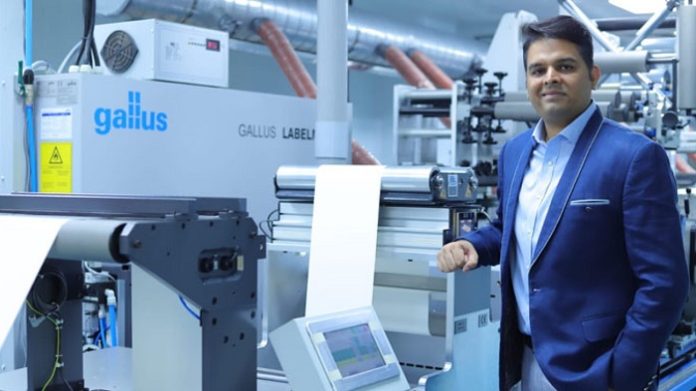Noida-based Monarch Graphics, a leading name in the label manufacturing business, started its journey in 2006. Bhrigav Jain, its techno-commercial director who has been associated with the labels industry since 2005, joined the operations in 2011.
When Jain joined the organization, it was doing some basic stuff such as barcode labels, barcode tags, and labels associated with the AIDC (automatic identification and data capture) industry, which deals with barcode printing, scanners, and software installations. In 2012, the company installed a label press from Orthotec, Taiwan.
In the year 2015, the enterprise ventured into flexo-label manufacturing with a highly-configured 9-color Gallus ECS 340. We have since developed our organizational structure, revolving around a lot of product labels, Jain said, adding the company still manufactures performance labels for the AIDC industry. “There are some high demanding customers looking at labels from the point of view of performance at very low and very high temperatures. The labels are part of an entire manufacturing process that requires a high degree of accuracy and an extremely low rate of rejection,” he said.
Monarch Graphics has grown from a workforce of 10 employees in 2011 to 80 employees in 2024. The company has two plants in Noida – one in sector 63, and the other in Hosiery Complex, which was launched just before the second wave of the Covid-19 pandemic in 2021. The mother plant in sector 63 Noida is still focused on high-performance label segments where they are producing very simple yet niche labels. The Hosiery Complex plant is more focused on highly efficient and decorated jobs where a lot of embellishments are involved, Jain said. Both plants stand at about 10,000 square feet each.
A Gallus Labelmaster LM440 was installed in the Hosiery Complex plant in 2021 to become more efficient and produce more complex labels. The plant was conceptualized to reduce manpower movement and deploy a high degree of automation, Jain shared.
Today, Monarch Graphics caters to the nutraceuticals, pharmaceuticals, fertilizers, garments & apparel, cosmetics, wine & spirits, automotive, and tire segments. Jain says Monarch Labels works across at least 15 label segments. It does some niche exports and is well spread out in its specialty segments. “Our expertise revolves around different kinds of solutions for different segments.”
To stay ahead of the competition in the labels industry, Jain tries to be more efficient and develops supply chain partners with whom he can build trust and get new products into the market. Great HR and employee retention policies are a must, along with being flexible and continuously increasing product offerings, he said.
50 different kinds of label stock
Monarch Graphics uses 50-odd kinds of label materials, which is one of the highest varieties of label stock for a label manufacturer, Jain said. The company serves customers who reach out in search of very typical label material. “We have developed expertise in the last 11 years to cross-sell label solutions across various segments. We have been able to move over some very standard materials such as chromo, PP silver, and PP whites, which you hear in the general market,” Jain shared.
He said they are widespread in terms of offering label raw materials to the end customers, he said. Monarch sources its label stock from reputed companies present in India such as Avery Dennison, UPM, Lintec and 3M.
Anti-counterfeiting solutions
A lot of technology companies have entered the anti-counterfeiting market and primarily focused on secured QR-code-based solutions, Jain shared, adding the players combining anti-counterfeiting with various technologies.
“In anti-counterfeiting, the days are gone when you could print very basic things such as microtext, hologram, and color-changing inks. Today’s anti-counterfeiting solutions are smart, QR-code enabled, involve two-step verification, and are technology-enabled. All counterfeiting solutions are a combination of legacy technologies such as holograms, security printing, and security papers but combined with smart technologies,” he said. Monarch Graphics is working with a lot of technology companies to offer these solutions to the end customers.
Label equipment purchase parameters
About the Gallus machines, Jain said, “The Gallus ECS 340 and the Gallus Labelmaster LM440 are enough to provide a diverse range of label solutions to the market. Owning a Gallus is very prestigious as these presses have a trouble-free nature. The Gallus team is very approachable and flexible in dealing with customer challenges.”
With entry-level label presses starting at US$ 150,000 to US$ 200,000 and going up to US$ 1,500,000, label printers are spoilt for choice in selecting machines according to what kind of label products they want to offer, what kind of segment they cater to, the market needs, the ROI the label manufacturer is looking at, and the price point at which he looks to sell the product. “The ROI of a conventional flexo press has increased from four years to six to seven years for machines that cost between US$ 600,000 and US$ 700,000 approximately,” Jain said.
The Indian labels industry
Earlier, most label manufacturers were present in Delhi or Mumbai, from where they used to meet the label requirements for the rest of the country. At present, it seems the Indian label industry is at a juncture where there is an influx of many new players. The market is getting localized instead of big label manufacturers supplying across the length and breadth of the country, he said.
With the starting investment point coming under US$ 150,000, the market will go through fragmentation at a rapid pace in the next three to five years with many new players entering the market in various towns and cities and trying to grab market share, he said, adding the number of label players should increase by at least 20% in the next two years.
“There is not much consolidation happening in the labels industry because the major label printers are family-owned businesses and it is very difficult to merge two family-run businesses. For a larger company to take over a family-run business is also very difficult. For this, a family-run business needs to be very organized in terms of operations and daily handling of businesses. Five family-owned businesses getting together and becoming a consortium is also very difficult,” he said.
The number of high-quality printers is going down while mid-quality printers producing mid-quality printing is now an accepted norm, he said. The major reason behind this is that the end customer is not able to differentiate between a mediocre print and a good-quality print. “The label printers producing the best are either overburdened or niche or don’t want to be in the rat race. Thus, the industry is heading towards acceptable print quality at higher efficiency and lower cost,” he said.
All label printers are today standing at the same juncture, Jain said. With diverse solutions available in the market, it is very difficult to choose the right path. Is the right path to go the digital way? Is it the right path to stay on a conventional flexo? Is it the right path to diversify into packaging?
About label printers diversifying into the packaging industry, he said, “I feel label printers should not try to be a jack of all trades and master of none. We are hardcore label printers and we should focus on that. It’s better to stay focused rather than be disoriented.”
Challenges in the Indian labels industry
Not only label manufacturers, but the entire printing industry is now facing a phenomenon where we are being asked about a breakdown of the cost of our products, Jain said, adding today the buyer dictates terms on our selling price. Secondly, a lot of printers lose money in the market as people do not pay on time or do not pay at all, he said. The lack of trained manpower is another problem.
Fluctuations in the price of raw material is a challenge that the industry needs to face as we are a global economy and cannot have the thought process of the ’90s, he said, adding there is a need to have secure supply chains, better partners, and better understandings to overcome supply shocks.
Training programs for schools
At the school level, students are clueless about the printing industry, Jain said. “I think it is very important for the printing organizations to volunteer and have an outreach program where senior secondary school students are invited to visit printers to help them understand the printing industry and the job opportunities. This is the stage when students make decisions on their career path. These could be good public schools or government-run schools where students are looking for a more technical job after turning 18,” he said.
Printing is a line where you learn with experience. Here, just textbook knowledge is not going to work, Jain said, adding printing school graduates have a basic understanding of the printing industry but need to back it up with experience. “All students coming out of universities are looking for a white-collar job. The printing industry has not been able to provide healthy working conditions – now it is up to the print industry as to how we can make this highly technical job look glorious.”
Expectations from drupa
Jain is attending the drupa show from 28 May – 7 June 2024 in Dusseldorf. “My expectations from drupa are more from the learning experience to understand what kind of diverse printing solutions and raw material solutions the companies would offer and where exactly the packaging industry is heading. I don’t expect big demonstrations and big machines – I think it will be more of electronic demonstrations running from their plants. Three areas of interest are what people are going to demonstrate in digital printing, ancillary equipment in roll form for embellishments, and the latest software in prepress,” he said.
The Hosiery Complex plant has been working very successfully for three years now, Jain said, adding the company is looking to expand in the next few years in the most efficient manner possible. The company has well-qualified staff and an operational team, he concluded.











